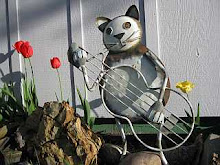Earlier this week the couple who are pasturing two horses here brought two more horses here.
They brought a mother and her filly. The filly's mother is the white horse and not the spotted horse as seen in the second photo.
The mother horse is blind in one eye and has partial vision in her other eye due to a past eye infection. Having a long mane doesn't help as she sometimes shakes her head to get the hair out of her eyes so she can see better.
The filly is quite skittish. She also tends to stay close to her mother.
The couple call the filly a pinhead due to the shape of her head. To me, a pinhead indicates a head that is too small for the body. To me the filly looks to have a large head in relationship to her body. Apparently 'pinhead' in this case means how the shape narrows in front.
At first the previous two horses wouldn't have anything to do with new horses. The dark horse would make noise and shake her head whenever one of the two new horses got too close.
Here they are ignoring the filly.
By the next morning they all got along as you can see the dark horse and the partially blind horse grooming each other.
Doesn't the white horse's mane remind you of Sam the sheepdog from the Looney Tunes cartoons?
Saturday, July 17, 2010
Subscribe to:
Post Comments (Atom)









2 comments:
Hi! I understand that the spotted filly with the dark neck is the daughter of the white horse. What kind of horse is she?
I understand that she is not related to the adult spotted horse. What kind of horse is that?
I'd be grateful if you'd drop me a note AT v e r i z o n DOT n e t -- I love spotted horses, though I don't know much. For instance, I don't know how much a bale of hay should cost. :)
I'm not sure what kind of horse the spotted filly is.
I believe the adult spotted horse is an Appaloosa horse.
I assume you are talking about square bales and not the big round bales.
The price of a square bale of hay varies. It depends on the price of hay which varies year to year depending on supply and demand. Also a bale of hay can range in weight from 40 some pounds to over 80 lbs depending on how the hay baler is set to pack the hay into bales. 60 to 70 lbs is a nice weight. Not too heavy, not too light.
Because a bale can vary in weight, the price of a bale is usually tied to the price of hay per ton. Then depending on the weight of the bales, one calculates how many bales it takes to make a ton and then divide to get a price per bale.
Lately buying hay in square bales costs a little more than buying hay in large round bales as square bales require more handling to move, etc. And people who prefer square bales often are horse owners who will pay more for hay than cattle ranchers will.
Post a Comment